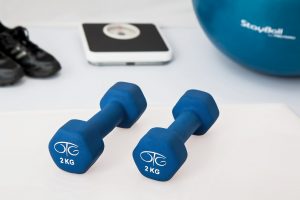Shorter workouts multiple times per day are beneficial.
We all know that weight loss is a simple concept that is hard to implement and maintain. For you to lose weight you need to eat less or exercise more and optimally, you should do both. The research supporting the benefits of regular exercise and eating less is overwhelming and undeniable. I do not think there is a single individual that would argue that regular exercise and a healthy diet is anything but good for you and your health.
If you are like me, you have very little time to dedicate to exercise. I don’t have the time or the desire to spend the money to invest in a gym membership. In the past, I have purchased a membership and failed to use it regularly. The question I always have is if I can insert steps into my day at work and get short bouts of exercise will it make a difference in my body fat and fitness level?
Most exercise guidelines, like those written by the American Heart Association, suggest that we get at least 30 minutes of moderate and/or vigorous physical activity five days a week. That is a total of 150 minutes of exercise a week. Could folding clothes, doing calisthenics between meetings, shoveling snow, washing dishes, raking the leaves, lugging laundry up the stairs, or pacing while chatting on the phone be as effective as a workout in the gym? Can these activities add to fitness if those short bursts of activity add up to 30 minutes a day?
Research on shorter bouts of exercise:
- One study by Fan looked at data on over 4,500 American adults between 18-64 years of age from the National Health and Nutrition Examination Survey (NANES). They found that subjects who accumulated exercise in short bursts of less than 10 minutes but who got at least 30 minutes of moderate activity five days a week had a lower body mass index than those who failed to acquire 150 minutes of exercise per week. The findings support that exercise less than 10 minutes is highly beneficial, supporting the public health promotion message that ‘‘every minute counts.’’[1].
The bottom line: Although longer periods of exercise is preferred and I am by no means saying that shorter bouts are better, shorter bursts of exercise are a legitimate option for those who struggle to find time to exercise. It appears that shorter bouts of exercise provide the same benefits regardless of the intensity. Exercise in smaller chunks may also increase adherence to a diet and exercise plan, and that is a good thing. Short bursts of physical activity appear to be as good for health as longer workouts and “every minute counts” toward better health so enjoy your 10-minute mini-plans in addition to your longer workouts.
References:
-
Boutcher, Stephen H. “High-Intensity Intermittent Exercise and Fat Loss.” Journal of Obesity. Hindawi Publishing Corporation, 2011. doi: 10.1155/2011/868305
-
Fan, Jessie X., Barbara B. Brown, Heidi Hanson, Lori Kowaleski-Jones, Ken R. Smith, and Cathleen D. Zick. “Moderate to Vigorous Physical Activity and Weight Outcomes: Does Every Minute Count?” American Journal of Health Promotion. SAGE Publications, September 2013. doi: 10.4278/ajhp.120606-qual-286
-
Jakicic, JM, RR Wing, BA Butler, and RJ Robertson. “Prescribing Exercise in Multiple Short Bouts versus One Continuous Bout: Effects on Adherence, Cardiorespiratory Fitness, and Weight Loss in Overweight Women.” International Journal of Obesity and Related Metabolic Disorders : Journal of the International Association for the Study of Obesity 19, no. 12 (December 1, 1995): 893–901. [PubMed]
-
Murphy, MH, and AE Hardman. “Training Effects of Short and Long Bouts of Brisk Walking in Sedentary Women.” Medicine and Science in Sports and Exercise 30, no. 1 (January 1, 1998): 152–57. [PubMed]
-
Trapp, E G, D J Chisholm, J Freund, and S H Boutcher. “The Effects of High-Intensity Intermittent Exercise Training on Fat Loss and Fasting Insulin Levels of Young Women.” International Journal of Obesity. Springer Nature, January 15, 2008. doi: 10.1038/sj.ijo.0803781
-
Walhin, Jean‐Philippe, Natalie C. Dixon, James A. Betts, and Dylan Thompson. “The Impact of Exercise Intensity on Whole Body and Adipose Tissue Metabolism during Energy Restriction in Sedentary Overweight Men and Postmenopausal Women.” Physiological Reports. Wiley-Blackwell, December 2016. doi: 10.14814/phy2.13026









Be the first to comment on "Research: Can Shorter Bouts of Exercise Help Fitness and Fat Loss?"